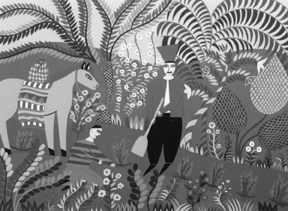Encyclopedia of Arab American Artists: Artists of the American Mosaic
By Fayeq Oweis
Greenwood Press, 2008, 336 pp.
The arts and culture have deep roots in the Arab psyche, and the craftwork and ideas that Arab Americans bring to the fine arts combine to form a rich mosaic. A new book titled “Encyclopedia of Arab American Artists: Artists of the American Mosaic” by Fayeq Oweis does an excellent job of showcasing the contributions and promise of about 100 Arab-American artists, presenting their work in their words and telling their varied and interesting stories. With an emphasis on the visual arts, the talented individuals profiled in this collection of short biographies work in a wide array of media from watercolor and oils, to sculpture, mixed media, installations and even collective murals. Their individual visions are brought to the forefront in abstract terms as well as overt symbolism, and their various approaches to the visual arts ultimately achieve a cohesive whole.
Thematically, patterns emerge as the artists’ stories unfold. Struggle and dispossession as both mindset and way of life naturally play key roles; struggle against oppression and corruption, against foreign occupation, against despair and hopelessness. War and peace, the Palestinian Diaspora and the chaos and bloodshed that have so decimated parts of the Arab world and the Arab nation often serve as points of departure.
In “Strange Fruit,” Moroccan-born multimedia and conceptual artist Abdelali Dahrouche leads the observer across a gallery floor strewn with mock cluster bombs to view a painting of an olive tree. In “Nothing personal, just economic interest” or “We are not the last,” the surrealism of Lebanese American Chawky Frenn awakens our basic hopes and fears. In this disturbing painting we find a woman casually holding her young son in her arms as they face an apocalypse. On side panels, meanwhile, gutted sheep hang from a butcher’s hook.
Traditional art plays an important role in the Arab world and many Arab-American artists have adapted these cherished and popular forms. Calligraphy and the written word, cornerstones of Arab artistic and cultural expression, transform themselves in the art of Arab Americans. In Hashim Al Tawil’s oil and mixed media “Monument for Iraq”, a strange combination of the ancient and the modern come together in a textural, almost cuneiform Arabic script. “Calligraphy Door” by Nahda Alsalah Balaa imposes a passage from the Qur’an over a rustic wooden door, slightly ajar, representing an open door to knowledge.
In the racially-obsessed West, our unique identity as Americans of Arab heritage often defines our artistic outlook. Adnan Charara’s “I am Arab American” features a busy assemblage of scattered faces that work to form an American cityscape. Miro-like in its simplicity, the work projects an abstract element that effectively captures the racial “otherness” of the Arab-American experience.
“Encyclopedia of Arab American Artists” also brings together a curious mix of the generations, lending insight into the many ways things are seen. Nostalgia plays a role in the multi-media art of Joyce Dallal, for example, expressing a longing for a more stable past, while a quest for justice in a nebulous future underlies the work of Rheim Alkadhi. As well, it is interesting to notice the symbolism between the generations with marked differences; for example, in the esoteric lines of Zahi Khamis and Sari Ibrahim Khoury relative to the bold, in-your-face concept art of Emily Jacir and the photography of Aisha Mershani.
There is much to appreciate about the artists profiled in this excellent volume as each has a compelling story and deep dedication to the arts. As a journey through the pages of “Encyclopedia of Arab American Artists” makes clear, the significant talent and contributions brought to the visual arts by Arab Americans is impossible to ignore and a certain collective presence exists with all of those included in this rich text. Indeed, rather than being just a compilation of names and biographies, this work demonstrates that Arab-American art as a whole is more than just individual expression, it is the projection of a collective destiny.
This review appeared in Al Jadid, Vol. 16, no. 61
© Copyright 2011 AL JADID MAGAZINE

